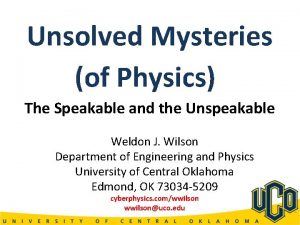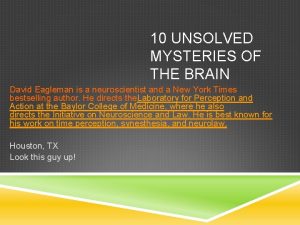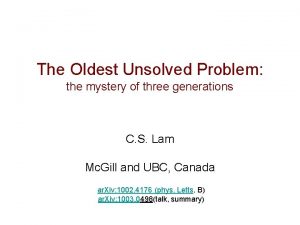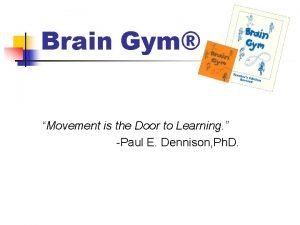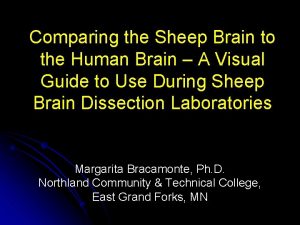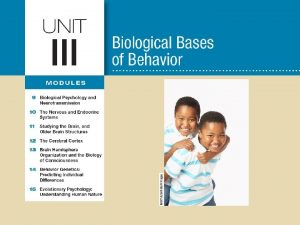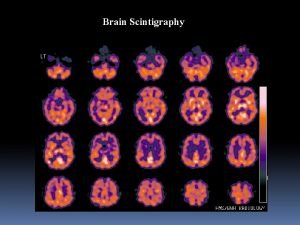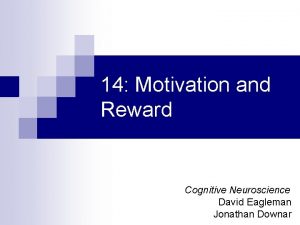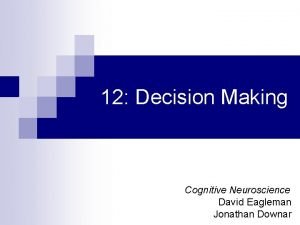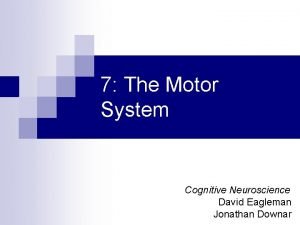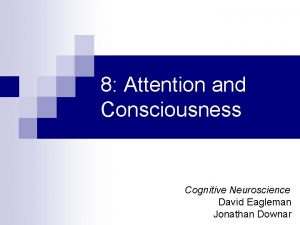10 UNSOLVED MYSTERIES OF THE BRAIN David Eagleman

10 UNSOLVED MYSTERIES OF THE BRAIN David Eagleman is a neuroscientist and a New York Times bestselling author. He directs the. Laboratory for Perception and Action at the Baylor College of Medicine, where he also directs the Initiative on Neuroscience and Law. He is best known for his work on time perception, synesthesia, and neurolaw. Houston, TX Look this guy up!

HOW IS INFORMATION CODED IN THE BRAIN? Neurons, the specialized cells of the brain, can produce brief spikes of voltage in their outer membranes. These electrical pulses travel along specialized extensions called axons to cause the release of chemical signals elsewhere in the brain. The binary, all or nothing spikes appear to carry information about the world:

BUT. . . It is likely that mental information is stored not in single cells but in populations of cells and patterns of their activity. However, it is currently not clear how to know which neurons belong to a particular group; worse still, current technologies (like sticking fine electrodes directly into the brain) are not well suited to measuring several thousand neurons at once. Nor is it simple to monitor the connections of even one neuron: A typical neuron in the cortex receives input from some 10, 000 other neurons.

HOW ARE MEMORIES STORED AND RETRIEVED? When you learn a new fact, like someone’s name, there are physical changes in the structure of your brain. But we don’t yet comprehend exactly what those changes are, how they are orchestrated across vast seas of synapses and neurons, how they embody knowledge, or how they are read out decades later for retrieval.

THUS. . . One complication is that there are many kinds of memories. The brain seems to distinguish short term memory (remembering a phone number just long enough to dial it) from long term memory (what you did on your last birthday). Within long term memory, declarative memories (like names and facts) are distinct from non declarative memories (riding a bicycle, being affected by a subliminal message), and within these general categories are numerous subtypes. Different brain structures seem to support different kinds of learning and memory; brain damage can lead to the loss of one type without disturbing the others.

AND. . . Memory retrieval is even more mysterious than storage. When I ask if you know Alex Ritchie, the answer is immediately obvious to you, and there is no good theory to explain how memory retrieval can happen so quickly. Moreover, the act of retrieval can destabilize the memory. When you recall a past event, the memory becomes temporarily susceptible to erasure. Some intriguing recent experiments show it is possible to chemically block memories from reforming during that window, suggesting new ethical questions that require careful consideration.

WHAT DOES THE BASELINE ACTIVITY IN THE BRAIN REPRESENT? Neuroscientists have mostly studied changes in brain activity that correlate with stimuli we can present in the laboratory, such as a picture, a touch, or a sound. But the activity of the brain at rest— its “baseline” activity—may prove to be the most important aspect of our mental lives. The awake, resting brain uses 20 percent of the body’s total oxygen, even though it makes up only 2 percent of the body’s mass. Some of the baseline activity may represent the brain restructuring knowledge in the background, simulating future states and events, or manipulating memories. Most things we care about—reminiscences, emotions, drives, plans, and so on—can occur with no external stimulus and no overt output that can be measured.

BUT. . . In the traditional view of perception, information from the outside world pours into the senses, works its way through the brain, and makes itself consciously seen, heard, and felt. But many scientists are coming to think that sensory input may merely revise ongoing internal activity in the brain. Note, for example, that sensory input is superfluous for perception: When your eyes are closed during dreaming, you still enjoy rich visual experience. The awake state may be essentially the same as the dreaming state, only partially anchored by external stimuli. In this view, your conscious life is an awake dream.

HOW DO BRAINS SIMULATE THE FUTURE? We know little about how the brain’s future simulator works because traditional neuroscience technologies are best suited for correlating brain activity with explicit behaviors, not mental emulations. One idea suggests that the brain’s resources are devoted not only to processing stimuli and reacting to them (watching a ball come at you) but also to constructing an internal model of that outside world and extracting rules for how things tend to behave (knowing how balls move through the air).

AND. . . Many neuroscientists have suggested over the past few decades that perception arises not simply by building up bits of data through a hierarchy but rather by matching incoming sensory data against internally generated expectations.

WHAT ARE EMOTIONS? We often talk about brains as information processing systems, but any account of the brain that lacks an account of emotions, motivations, fears, and hopes is incomplete. Emotions are measurable physical responses to salient stimuli: the increased heartbeat and perspiration that accompany fear, the freezing response of a rat in the presence of a cat, or the extra muscle tension that accompanies anger. Feelings, on the other hand, are the subjective experiences that sometimes accompany these processes: the sensations of happiness, envy, sadness, and so on.

SO, . . . Modern views propose that emotions are brain states that quickly assign value to outcomes and provide a simple plan of action. Thus, emotion can be viewed as a type of computation, a rapid, automatic summary that initiates appropriate actions. One goal of emotional neuroscience is to understand the nature of the many disorders of emotion, depression being the most common and costly. Impulsive aggression and violence are also thought to be consequences of faulty emotion regulation.

WHAT IS INTELLIGENCE? Intelligence comes in many forms, but it is not known what intelligence—in any of its guises—means biologically. How do billions of neurons work together to manipulate knowledge, simulate novel situations, and erase inconsequential information? What happens when two concepts “fit” together and you suddenly see a solution to a problem? What happens in your brain when it suddenly dawns on you that the killer in the movie is actually the unsuspected wife? Do intelligent people store knowledge in a way that is more distilled, more varied, or more easily retrievable?

RECENT EXPERIMENTS Intelligence may not be underpinned by a single mechanism or a single neural area. Whatever intelligence is, it lies at the heart of what is special about Homo sapiens. Other species are hardwired to solve particular problems, while our ability to abstract allows us to solve an open ended series of problems. This means that studies of intelligence in mice and monkeys may be barking up the wrong family tree.

HOW IS TIME REPRESENTED IN YOUR BRAIN? Hundred yard dashes begin with a gunshot rather than a strobe light because your brain can react more quickly to a bang than to a flash. Yet as soon as we get outside the realm of motor reactions and into the realm of perception (what you report that you saw and heard), the story changes. When it comes to awareness, the brain goes through a good deal of trouble to synchronize incoming signals that are processed at very different speeds.

YOUR BRAIN PLAYS TRICKS! For a simple example of how your brain plays tricks with time, look in the mirror at your left eye. Now shift your gaze to your right eye. Your eye movements take time, of course, but you do not see your eyes move. It is as if the world instantly made the transition from one view to the next. What happened to that little gap in time? For that matter, what happens to the 80 milliseconds of darkness you should see every time you blink your eyes? Bottom line: Your notion of the smooth passage of time is a construction of the brain. Clarifying the picture of how the brain normally solves timing problems should give insight into what happens when temporal calibration goes wrong, as may happen in the brains of people with dyslexia. Sensory inputs that are out of sync also contribute to the risk of falls in elderly patients.

WHY DO BRAINS SLEEP AND DREAM? One of the most astonishing aspects of our lives is that we spend a third of our time in the strange world of sleep. Newborn babies spend about twice that. It is inordinately difficult to remain awake for more than a full day night cycle. In humans, continuous wakefulness of the nervous system results in mental derangement; rats deprived of sleep for 10 days die. All mammals sleep, reptiles and birds sleep, and voluntary breathers like dolphins sleep with one brain hemisphere dormant at a time. The evolutionary trend is clear, but the function of sleep is not.

THEORIES INCLUDE The universality of sleep, even though it comes at the cost of time and leaves the sleeper relatively defenseless, suggests a deep importance. There is no universally agreed upon answer, but there at least three popular (and nonexclusive) guesses. The first is that sleep is restorative, saving and replenishing the body’s energy stores. However, the high neural activity during sleep suggests there is more to the story. A second theory proposes that sleep allows the brain to run simulations of fighting, problem solving, and other key actions before testing them out in the real world. A third theory—the one that enjoys the most evidence—is that sleep plays a critical role in learning and consolidating memories and in forgetting inconsequential details. In other words, sleep allows the brain to store away the important stuff and take out the neural trash

RECENTLY THOUGH Recently, the spotlight has focused on REM sleep as the most important phase for locking memories into long term encoding. In one study, rats were trained to scurry around a track for a food reward. The researchers recorded activity in the neurons known as place cells, which showed distinct patterns of activity depending upon the rats’ location on the track. Later, while the rats dropped off into REM sleep, the recordings continued. During this sleep, the rats’ place cells often repeated the exact same pattern of activity that was seen when the animals ran. The correlation was so close, the researchers claimed, that as the animal “dreamed, ” they could reconstruct where it would be on the track if it had been awake—and whether the animal was dreaming of running or standing still. The emerging idea is that information replayed during sleep might determine which events we remember later. Sleep, in this view, is akin to an off line practice session. In several recent experiments, human subjects performing difficult tasks improved their scores between sessions on consecutive days, but not between sessions on the same day, implicating sleep in the learning process

HOW DO SPECIALIZED SYSTEMS OF THE BRAIN INTEGRATE WITH ONE ANOTHER? To the naked eye, no part of the brain’s surface looks terribly different from any other part. But when we measure activity, we find that different types of information lurk in each region of the neural territory. Within vision, for example, separate areas process motion, edges, faces, and colors. The territory of the adult brain is as fractured as a map of the countries of the world. Now that neuroscientists have a reasonable idea of how that territory is divided, we find ourselves looking at a strange assortment of brain networks involved with smell, hunger, pain, goal setting, temperature, prediction, and hundreds of other tasks. Despite their disparate functions, these systems seem to work together seamlessly. There almost no good ideas about how this occurs.

IT IS NOT UNDERSTOOD Nor is it understood how the brain coordinates its systems so rapidly. Brains are amazingly fast at this. So while the brain’s ability to do parallel processing is impressive, its ability to rapidly synthesize those parallel processes into a single, behavior guiding output is at least as significant. An animal running must go left or right around a tree; it cannot do both. There is no special anatomical location in the brain where information from all the different systems converges; rather, the specialized areas all interconnect with one another, forming a network of parallel and recurring links. Somehow, our integrated image of the world emerges from this complex labyrinthine network of brain structures. Surprisingly little study has been done on large, loopy networks like the ones in the brain—probably in part because it is easier to think about brains as tidy assembly lines than as dynamic networks.

WHAT IS CONSCIOUSNESS? An explanation of consciousness is one of the major unsolved problems of modern science. It may not turn out to be a single phenomenon; nonetheless, by way of a preliminary target, let’s think of it as the thing that flickers on when you wake up in the morning that was not there, in the exact same brain hardware, moments before.

AND. . . Neuroscientists believe that consciousness emerges from the material stuff of the brain primarily because even very small changes to your brain (say, by drugs or disease) can powerfully alter your subjective experiences. The heart of the problem is that we do not yet know how to engineer pieces and parts such that the resulting machine has the kind of private subjective experience that you and I take for granted. If I give you all the Tinkertoys in the world and tell you to hook them up so that they form a conscious machine, good luck. We don’t have a theory yet of how to do this; we don’t even know what theory will look like.

THIS INFORMATION COMES FROM IT MAY BE A GREAT WAY TO INTRODUCE THE BIOLOGY OF BEHAVIOR Article available on disk or flash Discovermagazine. com http: //discovermagazine. com/2007/aug/unsolved brain mysteries . US 1 GEJWJUR Teachers of Psychology blog http: //teachinghighschoolpsychology. blogspot. com
- Slides: 24

